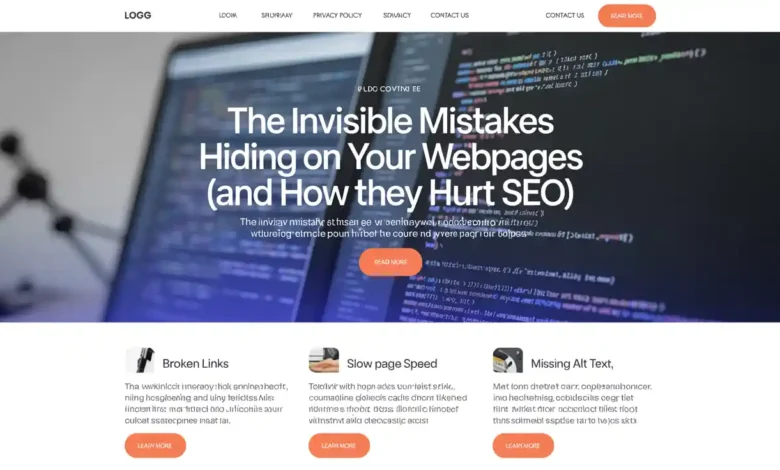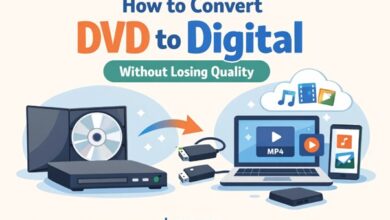The Invisible Mistakes Hiding on Your Webpages (And How They Hurt SEO)

Introduction: The Quiet SEO Killers You Don’t See Coming
Search engine optimization seems like trying to catch moving targets. When you finally get the hang of keyword research and content development, your rankings level off or even decline. The culprit? Usually, it’s not something visible on your site, it’s something going on in the background
These unseen technical problems quietly undermine your SEO work, rendering even your highest-quality content useless to search engines. While you’re busy writing ideal headlines and optimizing meta descriptions, unseen issues quietly destroy your site’s performance.
Most site owners only realize these problems after considerable ranking losses or after full audits. By this time, months of possible traffic and leads have already escaped. The good news is that when you do recognize what to look for, these problems become finite, and they often yield immediate wins for search visibility.
1. Slow Loading Pages You Didn’t Realize Were Slow
Page speed isn’t just about user convenience, it’s a real ranking factor in Google’s algorithm. Even though many website owners focus on making the homepage load fast, they often overlook the rest of the site. Product pages, blog posts, and landing pages can be much slower and still go unnoticed.
One of the most common issues? Oversized images. Photos uploaded without compression or in outdated formats can significantly slow down a page. Then there are background scripts, unnecessary plugins, and third-party tools, these might seem harmless, but they quietly drag down your performance.
The challenge is that what feels “fast enough” on your own device may not hold up for users on mobile phones or slower internet connections. That’s why it’s essential to run performance tests across multiple pages using tools like Google PageSpeed Insights or GTmetrix. These tools can flag hidden problems like render-blocking code, large media files, or server delays during peak hours.
Fixing these issues helps your visitors have a smoother experience, and it helps search engines rank your site more favorably.
2. Broken Internal Links and Redirect Chains
Internal links help both users and search engines navigate your website more easily. But over time, broken links can start to appear, usually without you even noticing. This often happens when URLs change, content gets removed, or your site structure is updated. Broken links lead to dead ends, which can confuse visitors and make it harder for search engines to explore your site properly.
Redirect chains can be just as damaging. Imagine Page A redirects to Page B, and then B redirects to Page C. While users eventually reach the final page, search engines have to jump through multiple steps. This makes it harder for search engines to index your pages and reduces the strength of the links between them.
Some common causes of these issues include:
- Updating page URLs or permalinks without adjusting internal links
- Moving content into new folders or categories
- Deleting outdated pages without setting up redirects
- Switching from HTTP to HTTPS without updating all internal references
To avoid these problems building up over time, it’s smart to perform routine internal link checks. A good marketing agency will often recommend doing link audits every quarter, especially for websites that publish regularly.
3. Unclear or Disorganized Heading Structure
Headings play a bigger role than just making content look neat, they guide both your readers and search engines through your page. Tags like H1, H2, and H3 create a roadmap of what your content is about. When this structure is inconsistent or poorly organized, it can confuse search engines and reduce your chances of ranking well.
For instance, having more than one H1 tag on a single page can make it unclear what the main focus is. Some websites also use headings just to change text size or style, which takes away from their true SEO value.
A clear heading structure should follow a logical order like this:
- H1 – The main title or focus of the page (use only once)
- H2 – Key sections or main ideas
- H3 – Supporting details or subpoints under H2
- H4-H6 – Optional deeper layers of detail if needed
When your headings are well-organized, users can quickly scan and find what they need.
4. Thin Content That Feels Complete—But Not
At first glance, your content might seem complete, but search engines may view it differently. This usually happens when a page touches on a topic without offering real depth or leaves out related questions that users expect to be answered. The issue isn’t always length, short articles can still be powerful, but if the content doesn’t fully meet the user’s intent or match what top-ranking competitors provide, it’s likely to be seen as thin.
You might notice symptoms like high bounce rates even though your title gets plenty of clicks. Or maybe your page ranks, but never quite breaks into the top five results. It might also struggle to attract backlinks or shares, another sign that users don’t find enough value to pass it along.
Improving thin content starts by figuring out what’s missing. Look at what searchers want, examine high-ranking pages, and identify the gaps in your own content. Filling in those blanks with useful, relevant information is a key part of effective on-page SEO optimization.
5. Messy or Inconsistent URL Structure
A clear and consistent URL makes it easier for both people and search engines to understand what the page contains. When URLs are well-structured, they contribute to better visibility in search results and make your site easier to navigate. But when URLs are cluttered or inconsistent, it can cause confusion and reduce your site’s SEO effectiveness.
Here are a some common issues to look out for:
- Adding dates to blog post URLs, which can make content look outdated over time.
- Automatically generated URLs filled with random characters or parameters.
- Switching between hyphens and underscores, making things inconsistent.
- Using categories in URLs that don’t reflect how your content is actually organized.
Keep your URLs short and clear so they match the content of the page. Use hyphens between words, skip anything unnecessary, and follow the same format across your site. This makes it easier for users to navigate and for search engines to understand your pages.
6. No Use of Structured Data Where It Matters
Structured data allows search engines to understand the meaning behind your content, even if it’s not visible on the page itself. It can help improve how your site appears in search results by unlocking features like rich snippets.
Still, many websites skip this step entirely. Whether it’s a blog post, product page, or FAQ section, using the right structured data markup can enhance how that content is displayed in search. For example, article markup supports blog visibility, product markup can highlight pricing or availability, and FAQ markup lets users see helpful answers right from the search page.
If you’re a local business, location markup is also key. Reviews and ratings can be marked up too, helping you stand out. While structured data doesn’t guarantee better search features, without it, your pages have no chance at all.
7. Pages Being Indexed That Shouldn’t Be
Sometimes, search engines include pages in their results that aren’t very useful to visitors. These could be backend pages, duplicate content, or archive pages with little information. When too many of these low-value pages show up in search results, they can reduce the overall quality signals your site sends to search engines.
To avoid this, your sitemap should only include pages you actually want to rank. You can use tools like robots.txt or add no-index tags to keep certain pages from being indexed.
Some examples of pages you might want to exclude:
- Thank you and confirmation pages
- Internal search result pages
- Printer-friendly versions of your content
- Additional pages in a paginated list
- Author archives that don’t offer original or helpful content
By running regular index audits, you can catch these pages early and make sure only the most valuable content is showing up in search results.
Conclusion: It’s the Little Things That Add Up
Technical issues on your website may go unnoticed at first, but over time, they can quietly reduce your visibility in search results. The upside is that fixing these kinds of problems, like slow pages or broken links, often leads to faster improvements than rewriting content alone.
It’s a smart move to start with a full site audit to uncover what’s holding your site back. Focus on updates that can have an immediate impact. At Lorphic, we often find that improving site speed and cleaning up internal links can quickly boost performance.
Remember, strong SEO isn’t just about publishing good content. It’s also about making sure that content is easy for search engines to find and understand. Balancing both the visible and behind-the-scenes elements is key to turning your efforts into real, measurable growth.



